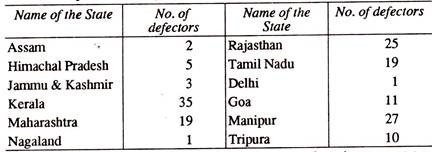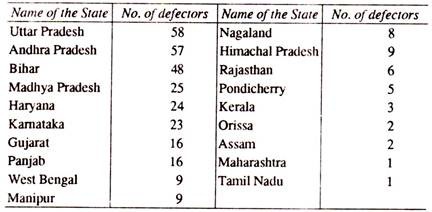ADVERTISEMENTS:
In this article we will discuss about the defection politics in India.
Defection politics in India started after Fourth General Elections held in 1967 and thereafter it continued to draw serious attention of the people. Prior to this there were also political defections when persons like Dr. Raghu Vira, Ashok Mehta and T. Prakasham left their parties. But at that time problem was not really serious because such instances were few and far between.
The cases being very few caused only ripples but not storms. It was, however, after 1967 that in many states Congress party did not come to power and thus had no clear cut majority. The opposition parties had ample opportunities to form their governments and thus both the sides started persuading elected legislators to join their side.
Allegations were made that the legislators changed very frequently their allegiance and in Haryana, it is said that a legislator changed his allegiance thrice in a day. Between March and December, 1967 out of total membership of about 3,450 state legislators about 320 changed their loyalties.
Leaving aside the states of Kerala, Tamil Nadu, Maharashtra and Nagaland, the problem of defection was existing almost everywhere, in some states that being very serious.
Between March 1967 and March 1970 in some states the members who left their political parties and joined other parties, the position was as under:
This does not mean that in other states/union territories there was no problem of defection. All that is meant is that there it was comparatively less serious.
ADVERTISEMENTS:
The position in respect of other states/union territories was as under:
Whereas party members, defected in large numbers in many states, independents also did not lag-behind. During this period of 3 years as many as 327 independent legislators defected in the state legislatures.
Their position in each state was:
The Parliament was also not free from detections. During this period 148 party and four independent members here also defected.
This politics of defection or what was then began to be called as that of ‘Aya Ram’ and ‘Gaya Ram’ seemed playing such a prominent role that in many states, governments survived and went out of power on the activities and attitudes of these political turn coats.
To quote few examples, these were the governments of Charan Singh and T.N. Singh in U.P.; G.N. Singh in M.P.; Rao Birendra Singh in Haryana, Gurnam Singh, Prakash Singh Badal and Lachman Singh Gill in Panjab; M.P. Sinha, B.P. Mandal, Daroga Rai and Karpoori Thakur in Bihar and E.S.M. Namoodripad in Kerala. This politics of turn coat, created a lot of inconvenience to the bureaucracy and made that in a way very strong and powerful.
There were frequent falls of governments resulting in political instability and delays in decision-making process at political level. In addition to this there was no continuity in policies, because each government which came to power followed its own policies, many a time undoing the work of previous governments.
This state of affairs continued when in 1971 general elections were held in the country and Congress party led by Smt. Indira Gandhi swept the polls not only at the centre but also in many states. There was, thus, comparative stability. Many turn coat politicians began to think in term of joining this Congress.
But in between there was an important happening. In 1969, Congress party got completely split. Many senior Congress men formed one group which began to be called syndicate Congress or Congress(O).
The group did not see eye to eye with the policies and programmes of the Prime Minister and the way in which government was functioning. Those who remained with the Prime Minister began to be called Congress (N). Thus, technically either of the group can be stated to have defected from the party.
In 1971, general elections were held for Parliament and 1972 some of the states went to the polls. As a result of these elections Congress party headed by Smt. Indira Gandhi got a massive mandate and for some time it appeared as if there would be no defections, because the turn coats would not feel attracted to go out of the Congress; only other possibility being that some of the opposition members might join the Congress. But process of defection continued.
In November, 1972 former Orissa Chief Minister Biju Pattnaik revived his Utkal Congress. In February, 1973 he persuaded Industries Minister of Smt. Nandini Satpathy Government to resign, who joined Pattnaik’s newly founded Pragati Party with his supporters.
This reduced Nandini Satpathy’s Government to minority resulting in its downfall. Though Pattnaik claimed that he was in a position to form alternative government, yet Governor recommended dissolution of the House. Thus, defection politics in the state resulted in the down fall of one otherwise stable government.
The same drama was staged in Manipur where 10 MLAs belonging to ruling United Legislature party defected and formed a new group and joined hands with Congress and CPI. They claimed a majority in the House, but in this case also the Governor decided to dissolve the House.
Defection drama was played in Bihar also where 15 Bihar MLAs belonging to non-Congress parties decided to join the Congress.
ADVERTISEMENTS:
Manipur was again the scene of defection politics. In that state elections were held in February, 1974 where Manipur People’s Party and Manipur Hills Unions jointly won majority in the Assembly. But just after 4 months the latter party decided to leave the government and joined Progressive Democratic Front and thus the government was reduced to minority and had a fall.
In 1973, Pondicherry also faced the problem of instability created by defectors, left the ruling DMK and joined All India Anna DMK. The Chief Minister tendered his resignation to the Lt. Governor, who on his advice recommended dissolution of the House. President rule was imposed in the state in early January, 1974.
In March, 1975, several MLAs defected from ruling United Democratic Front and joined Nagaland Nationalist Organisation, thus, resulting in the fall of Front government. This provided an opportunity to Nationalist Organisation to form government.
But the new government had remained in power for hardly 10 days when again there were defections, reducing it to a minority. There was so much of instability that Governor L.P. Singh had no other alternative but to recommend the dissolution of the Assembly.
In 1975, internal emergency was declared throughout the country and with that many opposition leaders were put behind the bars. There was reduced political activity throughout the country and no body dared to join any opposition party. The result was that for 19 months during which emergency continued in the country, there was no defection.


